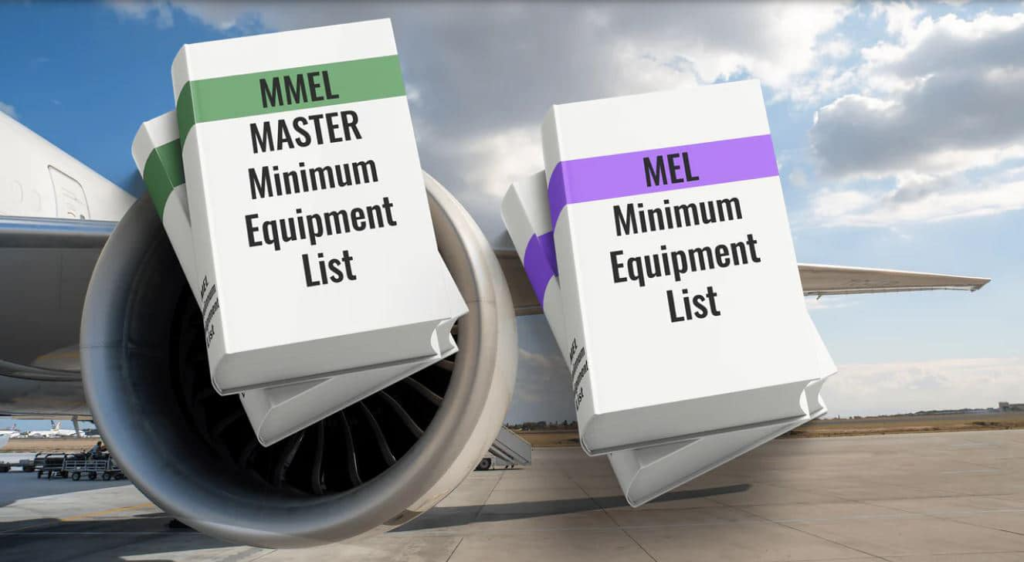
A minimum equipment list is the regulating authority and manufactures legal requirements for an aircraft to fly under specific conditions. The required equipment MUST be operational (unless there is some type of waiver) in order to be “air worthy” and meet “type design”.
The minimum equipment list (MEL) for an aircraft is a document that lists the items of equipment that may be inoperative on an aircraft without rendering the aircraft unsafe for flight. The MEL is specific to each type of aircraft and is developed by the aircraft manufacturer in consultation with the relevant regulatory authority. The MEL will vary depending on the type of aircraft, but typically includes items such as navigation and communication systems, lighting, and emergency equipment. Some examples of items that might be included on an MEL are:
- Navigation systems
- Communication systems
- Lighting
- Emergency equipment
- Oxygen systems
- Fuel systems
- Powerplants
- Flight instruments
- Automatic flight control systems
- Landing gear
- Brake systems
- Electrical systems
- Environmental control systems.
It is important to note that an MEL is not a substitute for a maintenance program and it is the pilot’s responsibility to ensure that the aircraft is safe for flight.
Larger aircraft will have a schedule of allowed defects and what remedies must be taken in order to continue to fly the airplane for a short period of time. The airline is usually given from 24hrs up to a week (depending on how serious) to fix problems.
For example you may have seen an aircraft with a bathroom or tray table duck-taped with a sign that says out of order do not use. The MEL will tell maintenance and crew what must be done to fix it – for example it may need to be fixed within 72hrs or the airplane will be grounded.
When equipment gets broken or inop there generally is a placard and an amount of time that equipment must get fixed or the plane is grounded. There may also be flight restrictions such as not flying in rain, speed limits, weight or cg limits, power settings, night prohibition, icing restrictions, certain altitude limits, etc.
Here are some additional details about the minimum equipment list (MEL) for aircraft:
- Purpose: The MEL is designed to provide guidance to pilots, maintenance personnel, and operators on the acceptable level of equipment that may be inoperative while still ensuring safe flight operations. It helps strike a balance between operational flexibility and safety by allowing certain systems to be temporarily inoperative under specific conditions.
- Development: The MEL is developed by the aircraft manufacturer in accordance with regulatory requirements. It takes into account factors like aircraft design, systems redundancy, operational considerations, and safety regulations. The specific MEL for an aircraft type is approved by the relevant aviation authority, such as the Federal Aviation Administration (FAA) in the United States or the European Union Aviation Safety Agency (EASA) in Europe.
- Configuration: The MEL is divided into different categories or levels, typically identified as A, B, and C. These levels indicate the level of inoperability permitted for various systems or equipment. Level A refers to items that must be operational for flight, Level B allows the aircraft to operate with certain systems inoperative under specific conditions, and Level C lists items that may be inoperative for a limited time or under certain conditions.
- Master MEL and Aircraft-Specific MEL: There are two types of MELs—Master MEL and Aircraft-Specific MEL. The Master MEL is developed by the aircraft manufacturer and covers a specific aircraft model or series. The aircraft operator may then create an Aircraft-Specific MEL based on the Master MEL, taking into account factors such as the aircraft’s specific configuration and installed equipment.
- Procedures and Compliance: Pilots and maintenance personnel must follow specific procedures outlined in the MEL to determine if an aircraft is airworthy with inoperative equipment. They need to verify that the inoperative equipment meets the conditions and limitations specified in the MEL, and additional procedures may be required to ensure safe operation.
- Record-Keeping: It is essential to maintain accurate records when operating under an MEL. This includes documenting the inoperative equipment, the specific MEL provisions being followed, and any required corrective actions or inspections that are performed.
The MEL is a critical tool in aviation safety management, enabling aircraft operators to continue operations while maintaining an acceptable level of safety. It helps ensure that aircraft can continue to fly with minor equipment issues while repairs or maintenance are being conducted.
By Aeropeep Team





